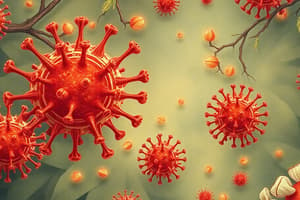Podcast
Questions and Answers
What is the primary process involved in stomatal transpiration?
What is the primary process involved in stomatal transpiration?
- Translocation of sugars through phloem
- Evaporation of water from soil
- Osmotic diffusion of water from xylem to stomata (correct)
- Active transport of nutrients into guard cells
During which condition is stomata likely to be open according to the starch-sugar interconversion hypothesis?
During which condition is stomata likely to be open according to the starch-sugar interconversion hypothesis?
- Night with low pH in guard cells
- Daytime with high CO2 concentration
- Daytime with alkaline medium in guard cells (correct)
- High atmospheric humidity
Which of the following is an external factor that affects the rate of transpiration?
Which of the following is an external factor that affects the rate of transpiration?
- Internal water condition
- Guard cell water condition
- Available soil water (correct)
- Rate of photosynthesis
What causes the guard cells to become turgid and open the stomata during the day?
What causes the guard cells to become turgid and open the stomata during the day?
During the night, what occurs in the guard cells that contributes to stomatal closure?
During the night, what occurs in the guard cells that contributes to stomatal closure?
Which transpiration type accounts for water loss through leaf surfaces not involved with stomata?
Which transpiration type accounts for water loss through leaf surfaces not involved with stomata?
What is a substance that acts as an antitranspirant to reduce transpiration rates?
What is a substance that acts as an antitranspirant to reduce transpiration rates?
Which mechanism is involved in the potassium ion transport within guard cells?
Which mechanism is involved in the potassium ion transport within guard cells?
Flashcards are hidden until you start studying
Study Notes
Transpiration
- Types of Transpiration:
- Stomatal transpiration: Water loss through stomata
- Cuticular transpiration: Water loss through the cuticle
- Lenticular transpiration: Water loss through lenticels
- Stomatal Transpiration Mechanism:
- Osmosis of water from xylem to intercellular spaces
- Opening and closing of stomata
- Diffusion of water vapor from intercellular spaces to the atmosphere
- Opening and Closing of Stomata:
- Starch-Sugar Interconversion Hypothesis:
- Daytime: CO2 used for photosynthesis makes the guard cells alkaline, converting insoluble starch to soluble sugar, increasing osmotic pressure, causing the guard cells to swell and open stomata.
- Nighttime: CO2 accumulates, making guard cells acidic, converting sugar back to starch, decreasing osmotic pressure, causing guard cells to lose water and close stomata.
- K+ ion Transport Mechanism:
- Potassium ions (K+) move into guard cells during the day due to active transport, increasing osmotic pressure, causing the guard cells to expand and open the stomata.
- K+ ions move out of the guard cells at night, decreasing osmotic pressure, causing them to shrink and close the stomata.
- Factors Affecting Rate of Transpiration:
- External:
- Atmospheric humidity
- Temperature
- Wind
- Light
- Available soil water
- Carbon dioxide (C02) concentration
- Internal:
- Internal water condition
- External:
- Starch-Sugar Interconversion Hypothesis:
- Plant Antitranspirants:
- Substances reducing transpiration rate.
- Examples: Abscisic acid (ABA), Phenyl Mercuric Acetate, increased C02 concentration.
Studying That Suits You
Use AI to generate personalized quizzes and flashcards to suit your learning preferences.




